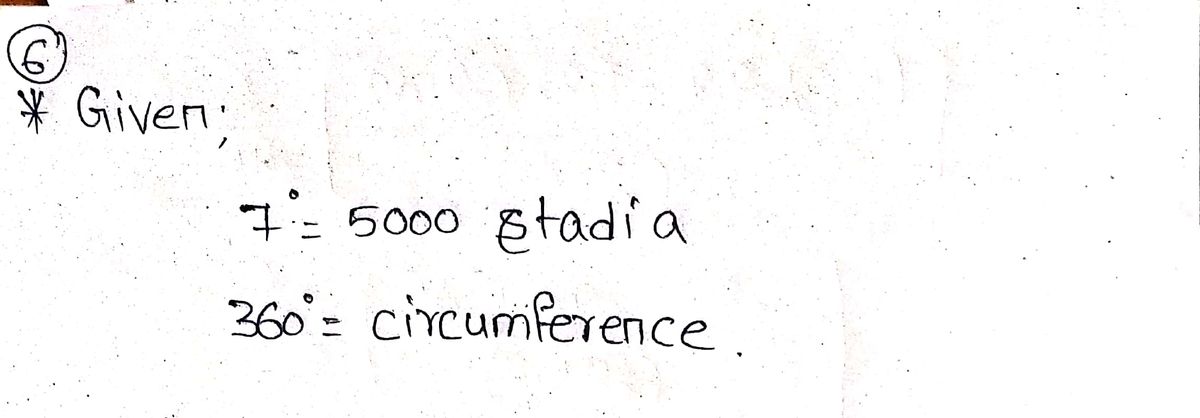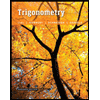6. In fact, Eratosthenes didn't compute the radius of the Earth but its circumference. He used the following proportion: 5,000 stadia 360 - circumference (Hie cromutiplydivide Compute the circumference, C, in stadia, and convert your result to km. C= km. 7. Compare to the accepted value of the circumference of the Eanth, using Caupiad =2 * Ra with Rea6378.1 km. km. Find the % aror. % error
6. In fact, Eratosthenes didn't compute the radius of the Earth but its circumference. He used the following proportion: 5,000 stadia 360 - circumference (Hie cromutiplydivide Compute the circumference, C, in stadia, and convert your result to km. C= km. 7. Compare to the accepted value of the circumference of the Eanth, using Caupiad =2 * Ra with Rea6378.1 km. km. Find the % aror. % error
Trigonometry (11th Edition)
11th Edition
ISBN:9780134217437
Author:Margaret L. Lial, John Hornsby, David I. Schneider, Callie Daniels
Publisher:Margaret L. Lial, John Hornsby, David I. Schneider, Callie Daniels
Chapter1: Trigonometric Functions
Section: Chapter Questions
Problem 1RE:
1. Give the measures of the complement and the supplement of an angle measuring 35°.
Related questions
Question

Transcribed Image Text:6. In fact, Eratosthenes didn't compute the radius of the Earth but its cireumference. He
used the following proportion:
7°
5,000 stadia
360°
circumference
(Hint cros-mukiply-divide)
Compute the circumference, C, in stadia, and convert your result to km.
km.
7. Compare to the accepted value of the circumference of the Earth, using Caoptol =2 n
REath with Rath =6378.1 km.
km.
Find the % error.
% eror

Transcribed Image Text:BACKGROUND
An ingenious solution to the Earth's circumference occured in 230 BC. Eratosthenes, a Greek
geographer, mathematician, music theorist, poet, astronomer, and philosopher, was reading in the
Library of Alexandria when he noticed an account for a deep well near Syene (now Aswan),
some distance to the south (800 km) in which at high noon on the longest day of the year the
bottom of the well was fully illuminated by the Sun. Eratosthenes exclaimed "Ah-ah!" (or
something like that), "I can solve for the circumference of the Earth!". In his mind's eye,
Eratosthenes could see that at Syene, at the moment when the bottom of the well was fully lit, the
Sun must have been at the Zenith (directly overhead). Yet he knew that at the same moment in
Alexandria vertical objects (like a tower, pole) cast shadows.
Here is the experiment perfomed by Eratosthenes (see the picture below).
• He erected a vertical pole at Alexandria (A) and measured the angle of its shadow at the
moment when the well at Syene (S) was fully illuminated;
• The angle of the pole equaled the angle formed by the points Alexandria (A), Earth's
center (C), and Syene (S). That angle proved to be approximately a = 7°.
• The distance between Syene and Alexandria is 5,000 stadia (the units of measure at the
time). I stadia = 157.5 m=0.1575 km.
Figure 1. The measure of Earth's circumference is based on the assumption that
Syene is on the Tropic of Cancer and the same meridian as Alexandria. The
image is adapted from a similar image prepared by Gico (Wikimedia).
Expert Solution
Step 1

Trending now
This is a popular solution!
Step by step
Solved in 2 steps with 2 images

Knowledge Booster
Learn more about
Need a deep-dive on the concept behind this application? Look no further. Learn more about this topic, trigonometry and related others by exploring similar questions and additional content below.Recommended textbooks for you

Trigonometry (11th Edition)
Trigonometry
ISBN:
9780134217437
Author:
Margaret L. Lial, John Hornsby, David I. Schneider, Callie Daniels
Publisher:
PEARSON

Trigonometry (MindTap Course List)
Trigonometry
ISBN:
9781305652224
Author:
Charles P. McKeague, Mark D. Turner
Publisher:
Cengage Learning


Trigonometry (11th Edition)
Trigonometry
ISBN:
9780134217437
Author:
Margaret L. Lial, John Hornsby, David I. Schneider, Callie Daniels
Publisher:
PEARSON

Trigonometry (MindTap Course List)
Trigonometry
ISBN:
9781305652224
Author:
Charles P. McKeague, Mark D. Turner
Publisher:
Cengage Learning


Trigonometry (MindTap Course List)
Trigonometry
ISBN:
9781337278461
Author:
Ron Larson
Publisher:
Cengage Learning